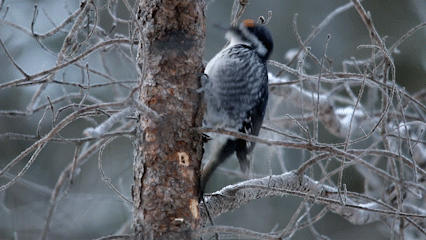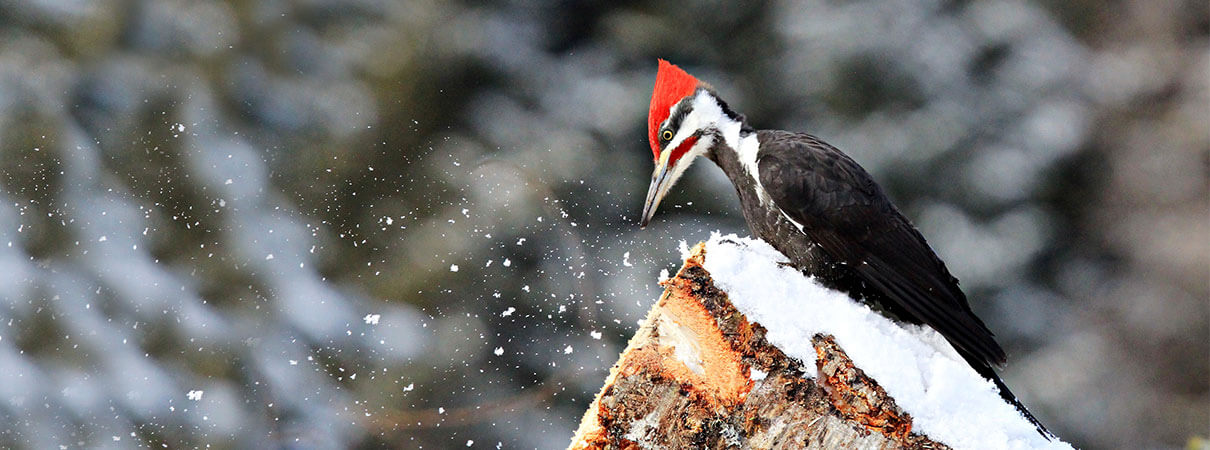Woodpecker Sounds: An Intro to Drumming, Calls, and More
Birds make many amazing sounds, from trills and warbles to screeches, hoots, and quacks. While not exactly considered the virtuosos of the bird world, woodpeckers do make many incredible noises, vocal and otherwise. Understanding the sounds woodpeckers make can give birders interesting insights into these beautiful birds and how they communicate.

Black-backed Woodpecker. Video by Justin Hoffman/Outdoors
A Feathered Drumline
The most famous and familiar woodpecker sounds aren't songs or calls, but drumming, which is also called rapping, tatting, and tattooing. Woodpeckers peck on objects to create sound patterns as communication. Resonant objects such as hollow trees, logs, and stumps are favored for drumming because their resonance increases the strength and volume of the drumming so it can be heard further away. Other objects that make popular woodpecker drumheads include:
• utility poles and transformer boxes
• metal chimneys and attic exhaust vents
• rain gutters and downspouts
• trash cans
• exterior light covers.

Pileated Woodpecker by Jesse Seniunas/Shutterstock
The tempo, rhythm, duration, and repetition of drumming patterns vary between different woodpecker species. Because these patterns can be very distinct, they can sometimes be used for species identification. In a particular area, birders can learn to decipher which woodpeckers are nearby just by hearing drumming patterns. But individual woodpeckers can tap and drum at different speeds and volumes, and sound travels differently depending upon weather and distance, so this takes practice!
Drumming means a lot more than just identification to the birds, however. A strong, vibrant drumming pattern indicates a healthy, dominant bird, one that controls a rich territory or would make a good mate.
Both male and female woodpeckers drum, most often in late winter or early spring when they are more actively seeking mates and establishing territories. Drumming is common in the morning, but woodpeckers may drum at any time of day.
Other Woodpecker Sounds
Woodpecker calls, even if they are composed of a variety of notes and cadences, lack distinct melodies, and are not considered “songs” in the same sense as those sung by warblers, cardinals, or mockingbirds. Nevertheless, woodpecker sounds can be just as varied and distinctive as other birds' songs and calls.
Calls may signal alarm, show agitation, or send a signal to a mate. Woodpeckers may not be as vocally adept as other species, but they do use churrs, purrs, rattles, chatters, screeches, and other short sounds, such as “peek” and “pik” notes.

"Red-shafted" Northern Flicker by Tim Zurowski/Shutterstock
Like drumming, the tempo, length, tone, and rhythm of woodpecker calls vary widely between species. Larger birds, like the tremendous Pileated Woodpecker, have deeper, more robust voices, while smaller species, such as the diminutive Downy Woodpecker, have brighter, lighter voices and higher tones. The Northern Flicker is one of the most vocal of the North American woodpeckers, uttering a laugh-like “ha-ha-ha-ha” call, soft screeching begging calls, and “kreee” or “kwirr” calls.
Using Woodpecker Sounds
People enjoying the outdoors may simply appreciate the symphony of woodpecker sounds, but those sounds can also be useful for bird identification and so much more. Learning the precise rhythms, tempos, and durations of drumming and calls can help pinpoint which woodpeckers are around. Furthermore, even if the sounds aren't precise enough for a positive identification, they can be useful to help triangulate a bird's location for a closer look. The type of sound, such as a relaxed call note compared to an alarmed chattering, may also help explain the bird's behavior and alert birders to other activity in the area.

Hairy Woodpecker by female_rck_953/Shutterstock
Protecting Woodpecker Sounds
The more we learn about woodpeckers and their sounds, the more we can appreciate these birds' diversity and distinctiveness. But without protection, it is possible that the drumming, chatters, laughs, and churring may be heard less and less.
American Bird Conservancy is working diligently to protect woodpeckers' habitats and to promote initiatives that can protect these birds. While many woodpeckers have healthy, even thriving, populations, increased habitat loss and pesticide use have put others at risk. The Ivory-billed Woodpecker, for example, likely went extinct following widespread habitat loss and shooting in the southeastern United States.
Species with limited ranges and specialized habitat requirements, such as the Lewis's, Red-cockaded, and White-headed Woodpeckers, especially benefit from targeted conservation efforts. These efforts include best practices for land management with birds in mind, increased awareness of the importance of forest conservation, and direct protection of the most critical areas of habitats.
With your help, woodpeckers can continue to make their varied sounds for generations to come.
 | Melissa Mayntz is a birder and a writer, naturally writing about birds. Her work has appeared in National Wildlife magazine, WildBird, Bird Watcher's Digest online, and other publications. She is the author of Migration: Exploring the Remarkable Journeys of Birds (Quadrille Publishing, 2020). |


















































